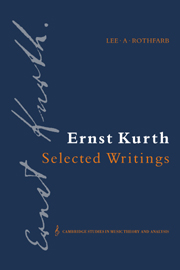
-
Select format
-
- Publisher:
- Cambridge University Press
- Publication date:
- December 2009
- July 1991
- ISBN:
- 9780511470288
- 9780521355223
- 9780521028240
- Dimensions:
- (228 x 152 mm)
- Weight & Pages:
- 0.52kg, 256 Pages
- Dimensions:
- (228 x 152 mm)
- Weight & Pages:
- 0.391kg, 256 Pages
You may already have access via personal or institutional login- Series:
- Cambridge Studies in Music Theory and Analysis (2)
Book description
This book provides a selection of annotated translations from Ernst Kurth's three best-known publications: Grundlagen des linearen Kontrapunkts (1917), Romantische Harmonik und ihre Krise in Wagners 'Tristan' (1920), and Bruckner (1925). Kurth's contemporaries considered these books to be pioneering studies in the music of J. S. Bach, Wagner and Bruckner. Professor Rothfarb's extensive introductory essay discusses the intellectual and socio-cultural environment in which Kurth was writing, referring to aspects of the early twentieth-century cultural renewal movements and to intellectual developments of the day in phenomenology, aesthetics and psychology. By reading Kurth against the cultural-intellectual background provided in the essay and commentaries, today's music historians and theorists can round out their picture of music theory in the early twentieth century.
Reviews
"Not only has Rothfarb mastered a wealth of material from Kurth's four principal writings, he has sifted as well through the complexity and abundance of thought, has organized it cogently, and has honed a precise yet fluent prose style of his own that reveals with impressive clarity Kurth's governing ideas and 'pre-analytic attitudes'." Notes
Contents
Metrics
Altmetric attention score
Full text views
Full text views help Loading metrics...
Loading metrics...
* Views captured on Cambridge Core between #date#. This data will be updated every 24 hours.
Usage data cannot currently be displayed.
Accessibility standard: Unknown
Why this information is here
This section outlines the accessibility features of this content - including support for screen readers, full keyboard navigation and high-contrast display options. This may not be relevant for you.
Accessibility Information
Accessibility compliance for the PDF of this book is currently unknown and may be updated in the future.


